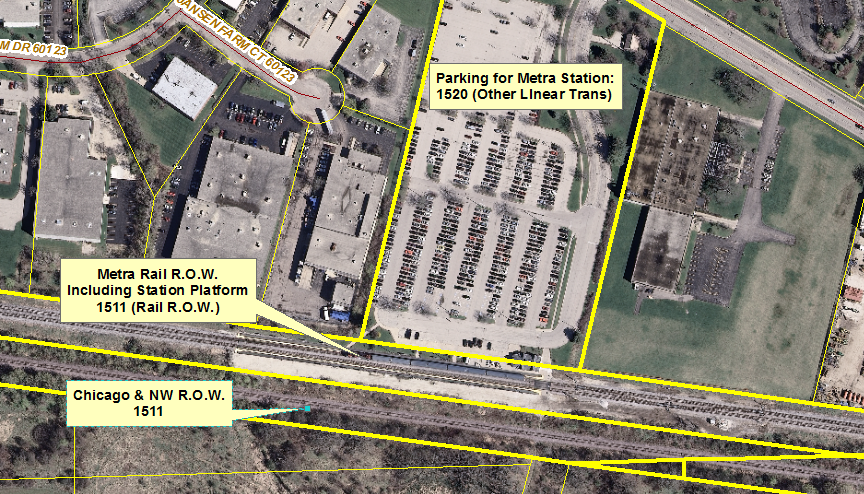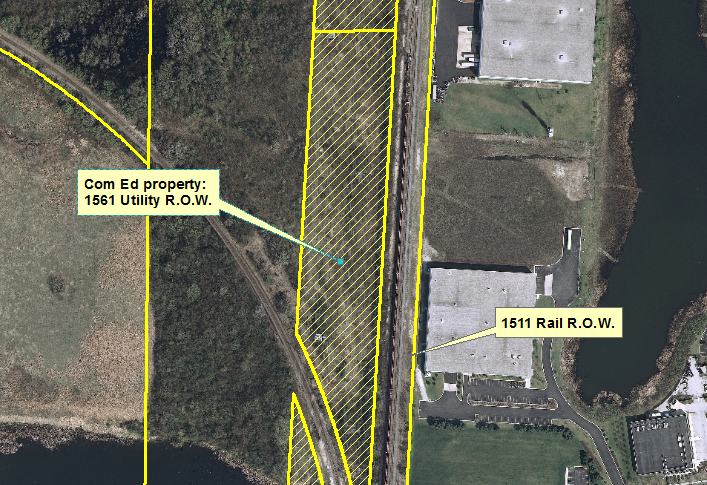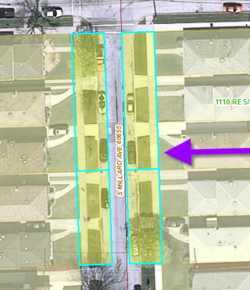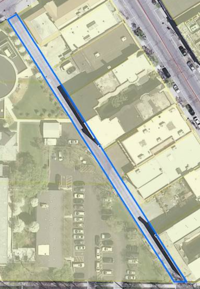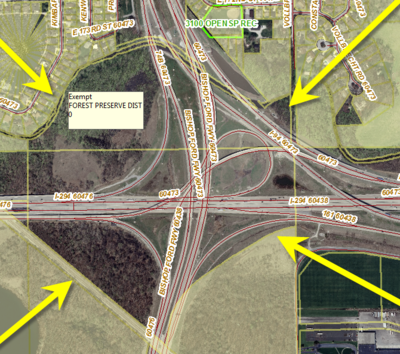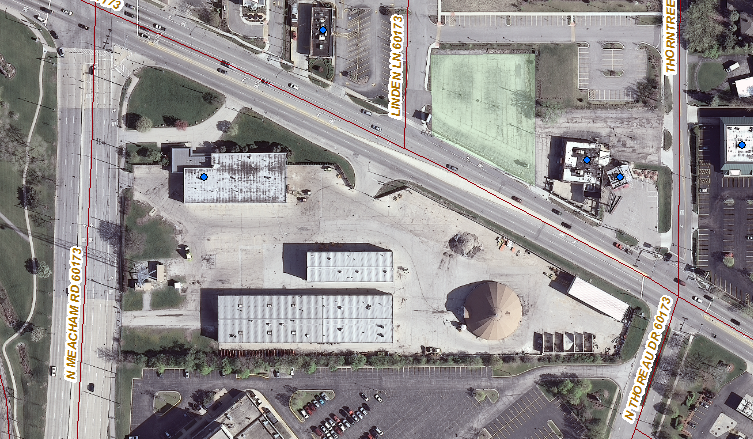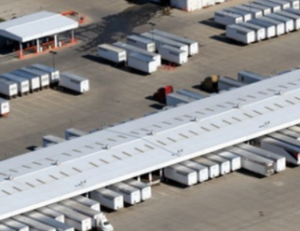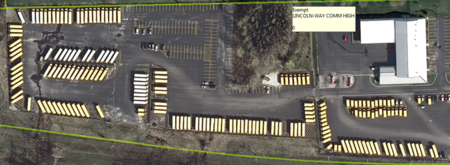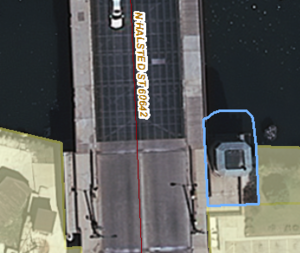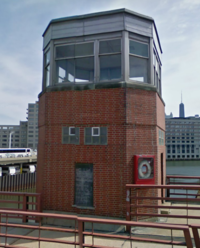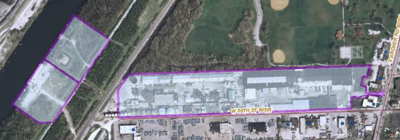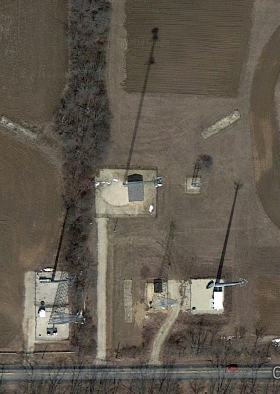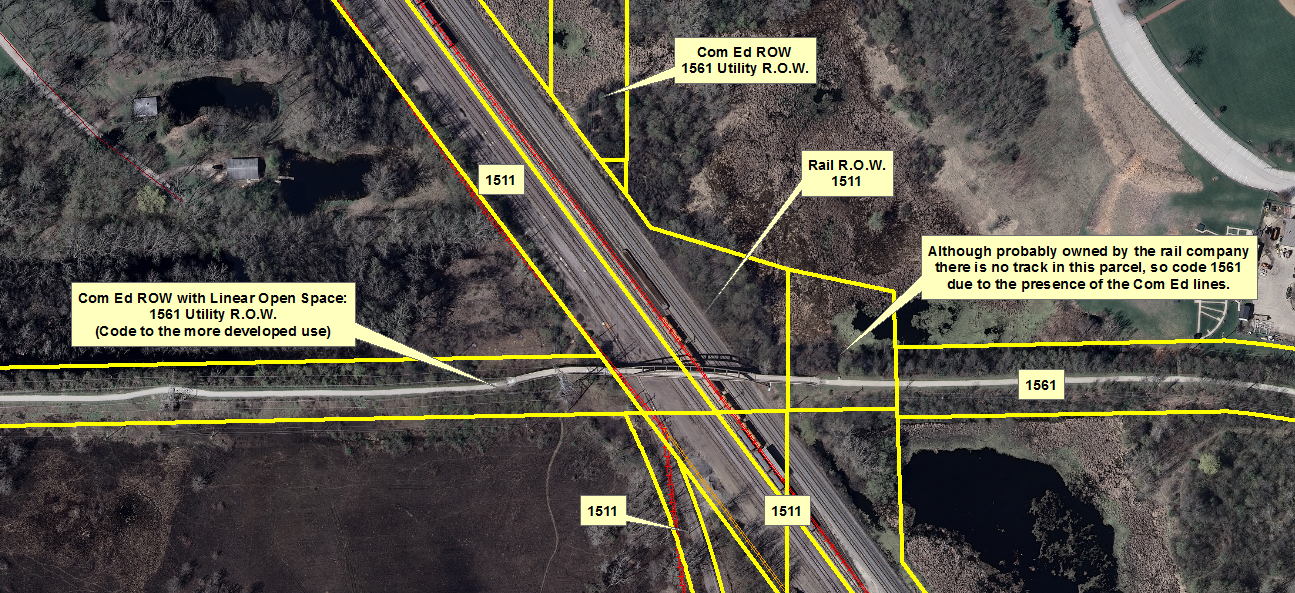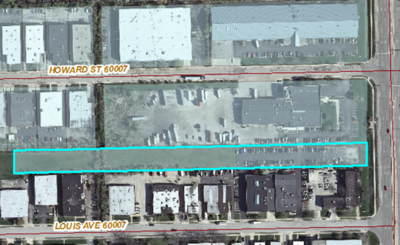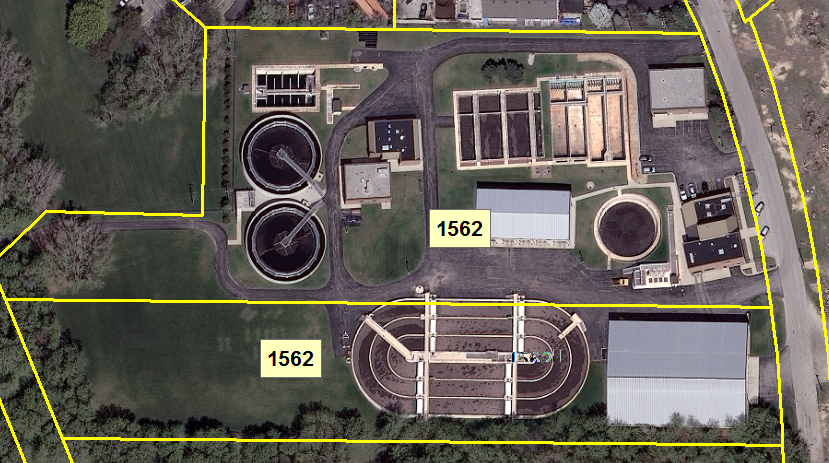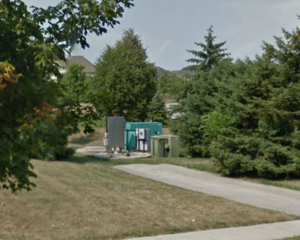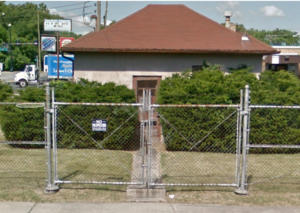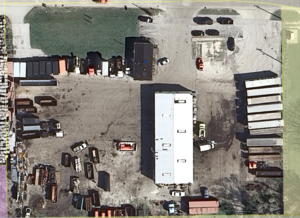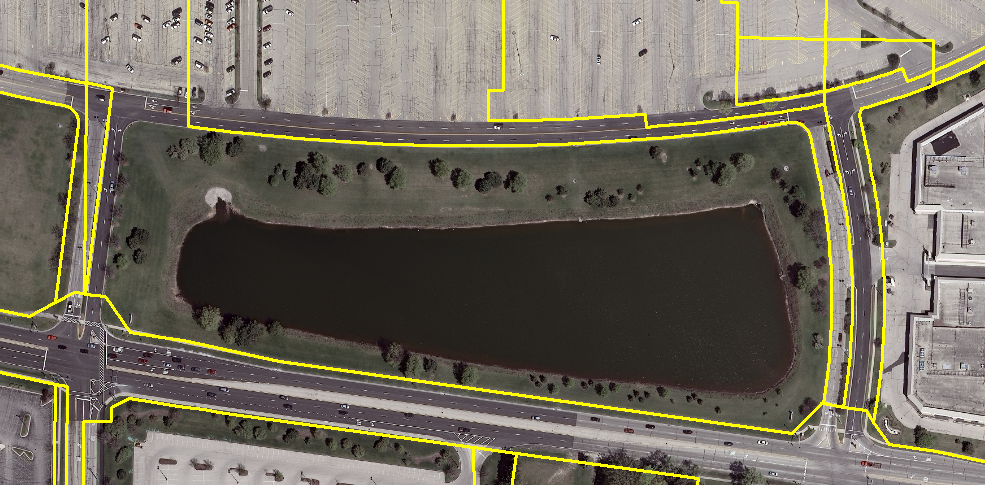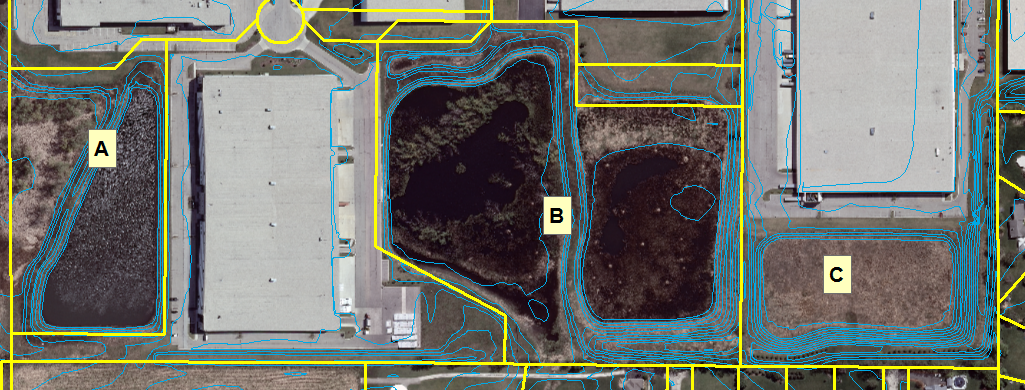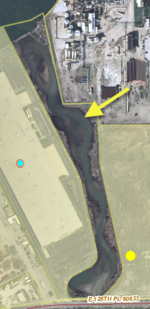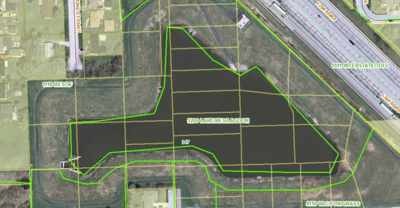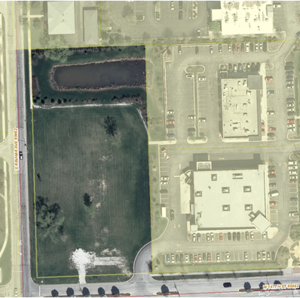Transportation/Communication/Utilities (TCU) Land Uses (1500 Series)
Table of Contents
- Transportation Right-of-Way (ROW) (1510 Series)
- Other Linear Transportation with Associated Facilities (1520)
- Aircraft Transportation (1530)
- Independent Automobile Parking (1540)
- Communication (1550)
- Utilities and Waste Facilities (1560 Series)
- Intermodal Facility (1570)
Transportation Right-of-Way (ROW) (1510 Series)
Rail ROW (1511)
Definition: Linear parcels owned by a rail transportation company, unless converted to non-rail use (i.e. rail-trail).
Discussion: Generally, these parcels are easy to identify, not only because of their shape but also by ownership: Union Pacific, Chicago & Northwestern, etc. Some counties do not bother to include the name of the rail company, but it should be clear due to their shape and co-incidence with the FRA Rail Lines reference layer. The long linear parcels can be not only coincident with the railroad tracks but also running along side the tracks as additional right-of-way for the railway company.
Examples:
Big Timber station, Elgin. Track ROWs coded 1511; parking for Metra station code 1520 Other Linear Trans.
Rail ROW (1511) alongside Com Ed Utility ROW (1561)
Q&A:
- Q: In the photo below the red sliver parcel is old railroad tracks. How do I code this? There are many such parcels in some industrial areas. Sometimes they have the same owner as an adjacent parcel; other times they do not.
-
A: In most instances whether it appears the tracks can be used or not, code such a parcel 1511 Rail ROW since it is still RIGHT-OF-WAY. If, however, the tracks are obviously not capable of being used AND they have the same owner as an adjacent parcel, then code them the same as that parcel.
-
Roadway (1512)
Definition: Linear parcel dominated by roadway.
Discussion: In Chicago, you will find parcels with a TAXNAME of City of Chicago that cover not only part of the street but also the parkway and public sidewalk in front of residences. Below is a photo of this. These will also be coded 1512 Roadway.
Examples:
Below is a photo of an alley behind commercial buildings which is a separate parcel and owned by the village. Code this as 1512 Roadway.
Q&A:
- Q: How do I code a parcel that is a driving lane to get to public parking for a downtown shopping area, but there is no actual parking in this parcel?
- A: Code this as 1512 Roadway.
- Q: The parcels in the photo below are owned by a forest preserve district, but they also have Interstate roadway and/or ramps on them. How do I code these?
-
A: In this case we need to use the “active land use” concept. Use your judgement about the relative land use implications of the active versus passive land use for a parcel. Consider 25% or more of the land area as a general rule of thumb for the active land use, but also use your own judgement about the implications regarding land use of the active versus passive use for the parcel to decided on a code. In this case, even though it is owned by a forest preserve district which would normally mean a code of 3300 and we do want to identify protected land, instead go with the active land use since it is very significant too as a major transportation highway and interchange. Code it 1512 Roadway.
-
Transportation ROW, Other or Mixed (1513)
Definition:
Discussion:
Examples:
Q&A:
Other Linear Transportation with Associated Facilities (1520)
Definition: Transportation-related activities separate from right-of-way parcels, including commuter rail stations and parking, as well as maintenance yards and freight terminals. This category also includes bus transportation, public and private including passenger terminals and bus ports, garaging, and maintenance facilities; motor freight and miscellaneous transportation including trucking terminals, trucking equipment and maintenance facilities, taxicab transportation, and vehicle emissions testing centers. Category also includes marine craft transportation including commercial docks (e.g. wharves, piers, and docks) and terminals where clearly independent from other uses. Facilities servicing recreational craft are coded as marinas (#1240, Cultural/Entertainment). Intermodal facilities are coded separately as 1570.
Discussion:
Examples:
Highway maintenance facilities. Such facilities might house a small office but are primarily for road maintenance vehicles and salt storage as is depicted below. It should be coded 1520 (Other Linear Trans), regardless if it’s owned by IDOT, a county highway department, or a municipality. On the other hand, if this type of facility shares a parcel with other municipal functions (i.e. village hall, police station, fire station), then code it 1330 Govt.
Freight or Trucking Terminal. Terminals used strictly for trucks to load/unload freight with no facilities for warehousing of goods and which are not a company distribution center can be identified by seeing that there are MANY trucks and freight bays but NO PLACE for goods to remain for any length of time. If the parcel contains a warehouse or distribution center with large space for goods storage in addition to truck bays, then it would be coded either 1420 or 1432 depending on the size. Below is a photo of a freight/trucking terminal which would be coded 1520.
Q&A:
- Q: Below is a photo of a school bus garage and parking on a parcel that is owned by a school district. It is not adjacent to any school, but rather in an industrial area. How should I code this?
-
A: Even though the parcel is owned by a school district, the busses are used to transport students to and from schools and not to formally teach them anything in the transport process. Because of this, code it 1520 Other Linear Transportation instead of an Education code.
-
- Q: On the Chicago River and other rivers in Chicago, I find small parcels next to bridges like the one outlined in blue-grey in the photo below. How do I code these?
-
A: This is a bridge tender house. Also below is a StreetView photo of such a structure. Men called “Bridge Tenders” actually lived in these houses from the 1840’s until in some cases into the 1980’s in order to “tend” the bridges that had to be raised and lowered for boat traffic on the river. 1520 Other Linear Transporation will be the most appropriate code for these parcels. Some are currently used during the day by bridge tenders but no one now lives in one.
-
- Q: The photo below shows a large fiberglass manufacturing company with their manufacturing facility on W 59th St and then 2 additional parcels along the Sanitary & Ship Canal which were coded as Other Linear in 2005. How should I code these parcels along the canal?
-
A: Even though these two parcels along the canal are owned by the manufacturing company, it appears that location is involved in the transfer of goods to/from the factory. Therefore looking at those 2 parcels from a functional standpoint, they would once again be coded 1520 Other Linear Transportation even though they are owned by the manufacturing company. If the parcels were adjacent to the large manufacturing complex, then it could be appropriate to include them in the manufacturing code, but in this case, they are not.
-
Aircraft Transportation (1530)
Definition: Includes public and private-use airfields.
Discussion: Parcels that include airport-related activities (air freight, long-term parking, rental car facilities, etc) and are on airport property should be coded as 1530.
Examples:
Q&A:
- Q: How do I code parcels that are private air strip as part of a homeowners association?
- A: Code the parcels that strictly have to do with aircraft transportation as 1530.
- Q: How do I code VOR’s and other facilities necessary for air transportation?
- A: For 2010 Land Use, only code actual runway facilities as 1530. Code VOR’s and Air Traffic Control Centers, for example, as Government.
Independent Automobile Parking (1540)
Definition: Non-residential off-street parking with or without a multi-level structure. This includes municipal lots which would be parcels owned by a municipality. Parking lots associated with another land use are coded to that particular use.
Discussion: Parking associated with a Metra station, even if owned by a municipality, code as part of the railroad facility (1520).
Parcels that are parking lots and/or multi-level structures and that are owned by a municipality in a commercial area are often off-street parking for the public and therefore would have this code. In some cases they are next to a municipal office building and then would be coded govenment as would the building. Using Street View on Google Maps or Bing Maps is often a good way to definitely identify the type of parking it is by reading signs at the parking lot entrances.
Examples:
Q&A:
- Q: How do I code a parcel that is a driving lane to get to public parking for a downtown shopping area, but there is no actual parking in this parcel?
- A: Code this as 1513 Roadway.
Communication (1550)
Definition: This category includes telephone, telegraph, radio, and television including towers, dishes, microwave facilities, and other communication not elsewhere classified. These communications towers may be owned by a private company or a government entity. In any case, a communications tower with no other significant developed land use on the parcel would be coded as 1550 Communications.
Discussion: This category now only covers the actual communications structures such as those mentioned above. It does not include an AT&T office building which would be coded OFFICE, nor does it include a service building where you would see infrastructure service trucks and where repair personnel would be based when not in the field. These buildings would be coded usually based on the county code. For example, if a service building was in an industrial area and coded industrial by the county, then the landuse code would be 1420 Industrial, general.
Examples: The photo below is a birds eye view of land that is contained in one or more small land use parcels. For each parcel, the tower is the only significant land use. When you suspect a communications tower, it is often better to use the internet to view the area at an oblique view to better see the actual tower. You often can also see the base and shadow of the tower in aerial photography if you look closely.
Q&A:
Utilities and Waste Facilities (1560 Series)
Utility Right-of-Way (1561)
Definition: Linear parcels owned by Nicor, Peoples Gas, or Commonwealth Edison/Exelon.
Discussion:
Examples:
Q&A:
- Q: How about a Com Ed linear ROW that also has a large number of trucks from some other company parked on it? How do I code this?
- A: The 1561 ROW code takes precedent unless there is an actual large building from some other organization on the ROW land.
- Q: How about a situation in which a utility ROW also has a bicycle path on it? Which do I code, for the utility ROW or for the bike path?
- A: The parcel owner sways how the parcel will be coded. In this situation, code 1561 Utility Right-of-Way even though there is also a bike path on the parcel.
- Q: The photo below shows a parcel owned by the gas company which also has a parking lot for adjoining commercial buildings on a good portion of the parcel. How do I code this?
-
A: Once again, in this situation the parcel owner sways how the parcel will be coded. Code 1561 Utility Right-of-Way unless there is an actual large building, not part of the utility owner, on a good portion of the parcel.
-
- Q: How do I code a ComEd substation?
- A: If the parcel just covers the substation, code it 1564 Other Utility/Waste. If the parcel is a long right-of-way parcel that has the substation on a part of the parcel, code the parcel 1561 Utility Right-of-Way.
Wastewater Treatment Facility (1562)
Definition: Permitted municipal wastewater treatment plants. These are publicly-owned, meaning taxpayer-funded, wastewater treatment facilities.
Discussion: A good reference layer essential to use to identify these publicly-owned WWTP’s (Wastewater Treatment Plants) is the one of Waterwater Treatment Plants based on NPDES (Nat. Pollutant Discharge Elimination System) records provided by the Illinois EPA.
You may find some small wasterwater treatment facilities that are NOT owned by a government taxing body, that are being used and funded by a nearby industrial or local housing development, and that are not in the WWTP reference layer. Code these Other Utility/Waste 1564. These are not general taxpayer-supported.
In some towns you may find a parcel owned by the sanitary district that is a large, green field in which you can see large circles such as the one in the municipality of Wasco. While it is used to treat grey waste water, it is not a treatment plant or facility so code such a green field with large circles Other Utility/Waste 1564 instead of using this WWTP code.
Examples:
Wastewater treatment plant, Carpentersville.
Q&A:
Landfill (1563)
Definition: Includes closed landfills, unless converted to another active use (i.e. golf course).
Discussion:
Examples:
Q&A:
- Q: In the photo below are parcels owned by Waster Management (parcels outlined in purple) and other parcels owned by Metro Water Reclamation District (parcels outlined in blue. This is to the west of the Calumet River just south of E 134th St on the far south side of Chicago. How should I code these?
-
A: It looks like the Waste Management parcels should be coded 1563 Landfill. The water part of the MWRD properties do NOT seem to serve a detention/retention function. Parcels in Chicago owned by the MWRD are often along waterways and have a wide, and sometimes baffling, variety of uses. It also does not appear that the landfill extends onto these parcels. In this case, I suggest coding those parcels at least 50% water as 5000 Water and the rest 4140 Other Vacant. The exceptions are those parcels right along the Calumet River, which appear to be part of the famous Thomas J. O’Brien Lock & Dam, and which should be coded 1520 Other Linear Transportation.
-
Other Utility/Waste (1564)
Definition: Including: electric generation plants and substations; natural gas production plants and storage tanks; water pipelines; water towers and accompanying land; refuse and garbage plants; sorting of recyclables; incinerators. Updated for 2018: Data centers.
Discussion: Some parcels that contain water treatment activities will be coded 1564 instead of the 1562 for a qualifying Wastewater Treament Facility using the EPA reference layer. Read the discussion above for code 1562 for more on this.
Examples:
Example 1: Besides the WWTP 1562 discussion above, another example of water treatment activity in which the water is being aerated in large ponds is in the photo below. This is developer-owned property so it would be coded 1564 Other Utility/Waste.
Example 2: Below is an aerial photo and street view of a parcel owned by a bank in a residential area. On this parcel are some type of electrical boxes or electrical substations. Such a parcel would be coded 1564 Other Utility/Waste because of the significant utility-related equipment on it.
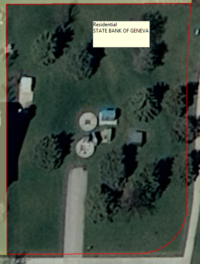
Q&A:
- Q: In residential areas, I occasionally have found what first appears to be a house owned by a government entity, usually a municipality. Upon closer inspection, I find it is a water pumping station in a house-like structure I guess to blend better into the neighborhood. How do I code this?
-
A: Yes, you often will find water pumping stations masquerading as small houses! Code this 1564 Other Utility/Waste. I have also seen that communications companies have a small building on a parcel and repair trucks parked nearby that were in residential areas. Code this the same. Also, below is a photo of a similar building in a commercial area owned by a municipality which is probably a pumping station. It too would be coded 1564.
-
- Q: I have often seen fairly small parcels usually owned by a municipality that contain what appears to be some sort of large metal boxes or containing pipes and man-hole type covers or some other utility-looking apparatus. How do I code this?
- A: These can all be coded 1564 too. The municipality owns this parcel because of this equipment related to some sort of utility. Sometimes what you see using Google Street View is a large man-hole cover or something similar.
- Q: How do I code a ComEd substation?
- A: If the parcel just covers the substation, code it 1564 Other Utility/Waste. If the parcel is a long right-of-way parcel that has the substation on a part of the parcel, code the parcel 1561 Utility Right-of-Way.
- Q: Below is an image of a privately owned small business that is a recyling and waste services company. The county use code is 517 Commercial One-story store which does not seem to fit what I can see on this parcel. How should I code this?
-
A: If we did know that there was some sort of retail activity going on here, we might code is Urban Mix, but it looks much for industrial. If the overall primary activity is just trucks and bins as can be seen in the photo, then code it 1420 General Industrial. If you did determine that there was actual sorting/processing of recyclables happening on this property, then it could be coded 1564 Other Utility/Waste.
-
Stormwater Management (1565)
Definition: Parcel is dominated by detention or retention basin, within or adjacent to a non-residential development.
Discussion: This category covers mainly detention basins and retention basins in Commercial and Industrial developments. Land with a similar function within a Residential development would code to 1151 Common Open Space. Definitions:
- Retention Basin has a permanent pool of water, with an elevated drain to release water if it rises above a certain level.
- Detention Basin temporarily holds stormwater runoff, and then slowly releases it. Most of the time it has no water, and will appear (on the aerial) as just a grassy area with a depression.
Retention basins should be fairly easy to spot–man-made ponds adjacent to or incorporated within a development. Detention basins are more difficult since, from the air, they usually just look like a grassy field. You can use your county’s contour data (found at V:\Environment_and_Natural_Resources\Topography), which will make detention basins more obvious. See the photo examples below.
Examples:
Retention basin at Spring Hill Mall. This will NOT code to 1565 because the parcel extends well into the developed area; instead it is coded with the remainder of the mall.
Portion of industrial park with contours turned on.
- “A” Retention basin: codes to 1565–primary function is stormwater management, and there is no development on the parcel.
- “B” Two basins, not necessarily permanent water but obviously functions as stormwater management, code 1565.
- “C” Detention basin: grassy area, with depression made visible through contours. Since the parcel extends into the developed area, though, it will code to the appropriate Industrial land use. If it were on its own parcel, it would code to 1565.
Example of when to code as Water: In the photo below, a separate parcel only contains what appears to be the remnants of a natural stream. Because it is not an actual detention/retention basin structure, code this Water 5000.
Deciding between 1151 Residential Common or 1565 Stormwater Management The retention pond and surrounding land in the photo below is Exempt by the county and owned by the City of Hickory Hills. Since it only has residential bordering on about 50% of the the property, we can rule out a Residential Common code. There is a Hickory Hills Park District which identified only a 4 acre Prairie View Park on the north side of this retention pond and does own one parcel on the north side of this pond so Open Space will only be a good code for that one very small parcel barely visible in this photo on the north side. All the other city-owned parcels should be coded 1565 Stormwater.
Q&A:
-
Q: How do I code the parcel in the photo below. It is coded as Vacant Land by the county. The tax owner does not match any of the adjacent parcels. About 30% of the parcel’s active use is the retention pond. The other use is passive in that it is vacant. Should this be treated with the 25% rule applied on Ag parcels so it would be Stormwater, 1565 or should the dominant land area be used for the code so it would be Vacant Commercial?
- A: In this case the code to use is 4120 Vacant Commercial even though the non-pond area is “passive”, it has high potential to become an active use since it is situated in the middle of all commercial activity.
Intermodal Facility (1570)
Definition: Sites involved in the transfer of freight between truck/rail/marine transport. Does not include single-company facilities (such as UPS), which will be classed as 1430 Warehousing/Distribution.
Discussion:
Examples:
Q&A:
